#: reddish brown bitter bolete :
Text
FOTD #137 : reddish brown bitter bolete! (tylopilus rubrobrunneus)
the reddish brown bitter bolete is a bolete fungus in the family boletaceae :-) there is little known about it, but it has so far been discovered in both the US & mexico.
the big question : can i bite it??
nah, it's inedible & - as the name suggests - has a very bitter taste.


[images : source & source]
[fungus description : none sadly</3]
#• fungus of the day !! •#[tylopilus rubrobrunneus]#: reddish brown bitter bolete :#137#||#image undescribed#undescribed#reddish brown bitter bolete#tylopilus rubrobrunneus#fungus#fungi#mushrooms#mushroom#earth#forestcore#foraging#mycology#nature#cottagecore#fotd#fungus of the day
65 notes
·
View notes
Text
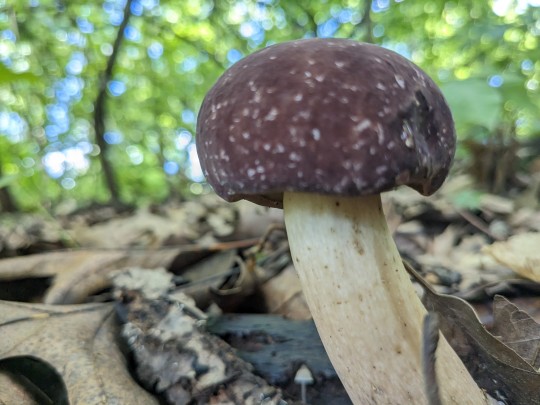
Reddish brown bitter bolete
Tylopilus rubrobrunneus

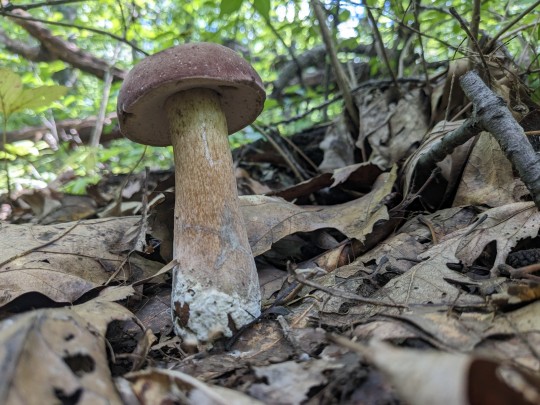
Aug. 14th, 2023
St. Louis County, Missouri, USA
Olivia R. Myers
@oliviarosaline
#nature#mushroom#mushrooms#bolete#boletes#fungi#fungus#mushroom photography#fungi photography#mycology#forest#forests#woods#naturecore#mushroomcore#Missouri#Ozarks#bitter bolete#nature pics#nature photography#exploring#forest floor
57 notes
·
View notes
Text
Boletes (Boletaceae)•Description: If you can picture a hamburger bun on a thick stalk,you will have a good idea of what most boletes look like. Thesesturdy, fleshy mushrooms can be mistaken at first glance forgilled mushrooms, but if you turn over a cap you will find aspongy layer of pores on the underside rather than bladelikegills.The pore layer can easily be pulled away from the cap.•Bolete caps are usually brownish or reddish-brown, while thepores may be whitish, yellow, orange, red, olive or brownish.Size: Up to 10" tall; caps 1" to 10" wide.•There are more than 200 species of boletes in North America.The King Bolete (Boletus edulis)is probably the best edible.•When and Where: Summer and fall; on the ground near orunder trees. Frequently found under pines.•Cautions: Boletes are considered a good, safe edible group forbeginning mushroom collectors. However, you should observethese cautions:•1. A few boletes are poisonous. To avoid these, don't eat anyboletes that have orange or red pores.•2. Some boletes, while not poisonous, are very distasteful. Checkthis by tasting a pinch of the raw mushroom cap. If it is bitter orotherwise unpleasant, throw it out.•3. To make them more digestible, boletes should be cookedbefore eating. If the cap is slimy, peel off the slime layer; itsometimes causes diarrhea.•4. Bugs seem to like boletes as much as people do, so check yourspecimens carefully. Boletes also tend to decay quickly. Be sureto collect and eat only fresh specimens.
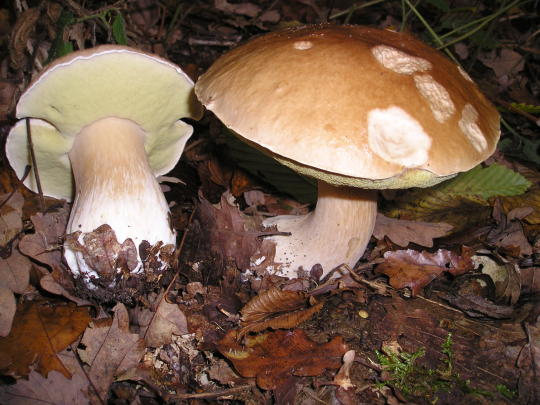
Sulfur Shelf(Laetiporus sulphureus)•Description: These mushrooms light up theforest with their brilliant orange-red caps andpale sulfur-yellow pore surfaces. Somespecimens fade to a peach or salmon color.•The sulfur shelf always grows on wood, usuallyin large masses of overlapping caps. It has nostem; the cap is attached directly to the wood.The pores are tiny.•Other names include chicken mushroom andchicken of the woods. Size 2" to 12" wide.•When and Where: Summer and fall; in clusterson living trees or dead wood.•Cautions: This is a distinctive mushroom with nopoisonous look-alikes. It does cause a mildallergic reaction (swollen lips) in some people.

Name - Ilma huda
Roll no. - 22/5665
Course- Bsc. (Hons) Botany
1 note
·
View note
Photo





These are from 2020 (last one from 2016). Photos by me.
These were curiosities along the way of the Fiery Gizzard Trail (90 minutes SE of Nashville), which I worked on as a volunteer (re-routing the trail after land ownership issues; my big accomplishment was building a bridge).
That first mushroom may or may not be a bleeding Destroying Angel (which would be highly toxic) or perhaps a False Death Cap; I’m highly uncertain and don’t really know anything about mushrooms. The orange ones are Cinnabar Red Chanterelles (a little bit certain). The purple ones are Reddish-brown Bitter Boletes (probably?), and look straight out of a children’s book if you ask me. The mantis is not a mushroom.
#tennessee#tracy city#fiery gizzard trail#grundy forest#wild mushrooms#praying mantis#mycology#me#mine
7 notes
·
View notes
Text
(Don't eat them raw ever even after being dried)
If you see this post please get your own information.Don't want anyone getting sick! or worse!
Inky caps

Find:grows in tight clusters in grass or on wood debris.
Time:summer and fall
Description:cap is up to 8 cm broad, light gray or gray-brown with furrow-lines radiating to the edges.gills are nearly free from the stem and white/grey when young.the flesh and gills of older specimens liquefies into a black inky mass when old.partial veil leaves an inferior, fibrous ring on the white stem.tip collect younger specimens and/or remove blackening areas which have a more bitter taste.tip: cooking with water shortly after collecting helps to prevent the dish from turning into a black inky mess.warning: causes a reaction of hot flushing and nausea if consumed with or followed by alcohol. Do not consume this mushroom unless abstaining from alcohol.
Look alikes: Shaggy Mane and Mica Cap(see below)
Jelly ears

Find:growing on dead deciduous trees almost always elder,but also other hardwoods.
Time:All year, especially autumn
Description:They are brown to almost black and develop on wood decay.Cup-shaped, becoming irregularly lobed and often ear shaped. Up to 7cm diameter, but usually smaller.Jelly ear naturally de- (and re-) hydrates in the wild, often looking like shrivelled, hard dark knobs, a fraction of their hydrated size and easy to miss, in warm dry weather. It can be picked in this state and rehydrated.Anyone on blood pressure medicine or expecting a surgery should not consume the mushrooms!
Look alikes:most similar looking species you are likely to encounter is Tremella foliacea, which is also translucent, medium brown to black, gelatinous and grows in overlapping flaps on decaying wood. Tremella foliacea has a lot more water in it, so its "squishier" , aka much easier to compress.this is an edible but very poor fungus, but being insubstantial it has no culinary value.
King Bolete Cep

Find:under beech, birch, scots pine, spruce; solitary or in clusters.
Time: spring,summer and autumn.
Description:partial veil is absent.firm young ceps are one of the tastiest wild foods, and extremely versatile. Older specimens are best dried, after which their flavour intensifies.Key identification features are the light to chestnut brown smooth cap with a white rim and often a hazy pale ‘bloom’. Ensure the stipe is pale with a slightly raised white net pattern (reticulum) on the top third. As a member of the bolete group of mushrooms, ceps have pores under the cap rather than gills. These start off pale grey, becoming yellow and eventually olive green in past-their-best specimens. Flesh should be unchangingly white throughout apart from a narrow claret-coloured line just under the skin of the cap.Ceps grow quickly and come in a wide and quirky range of shapes and sizes, and are often semi-decomposed before they reach maturity.
Look alikes: not edible Boletus huronensis (“False King Bolete”)Exceptionally dense. Found in hemlock. Pale yellow pores slowly bruise green-blue, resolving toward brown. Often has a “tide mark” on the stem. Netting is rare. Often tastes sweet.Sometimes has a disagreeable garlic or skunky odor.May have an unusual lack of bug holes.This is the only mushroom in North America that can have non-bluing yellow pores and also be a sick-maker.listed in many old books as edible, huronensis has been blamed for some notorious, multi-day, projectile food poisonings.
Lobster Mushroom

Find:conifer forests. They can be found under cedars and Douglas firs, growing from under loose forest floor material.
Time:spring,summer and fall.
Description:not a mushroom, but a parasitic fungus that grows on mushrooms.the fungus turns the host mushroom a bright reddish orange.the fungus deforms the surface of the host mushroom to be coarse, cracked, and dotted with tiny white pimples.the fungus eventually twists the mushroom into an irregular shape, making the host unidentifiable.has a seafood-like flavor that is highly variable.has a firm, dense texture.fresh specimens have a white interior.appears in summer and fall following rainy weather.They" have confirmed that none of the Hypomyces lactifluorum hosts are toxic.
Look alikes:There are no mushrooms that look like lobster mushrooms. As such, there are no poisonous lookalikes for lobster mushrooms.
Meadow Mushroom
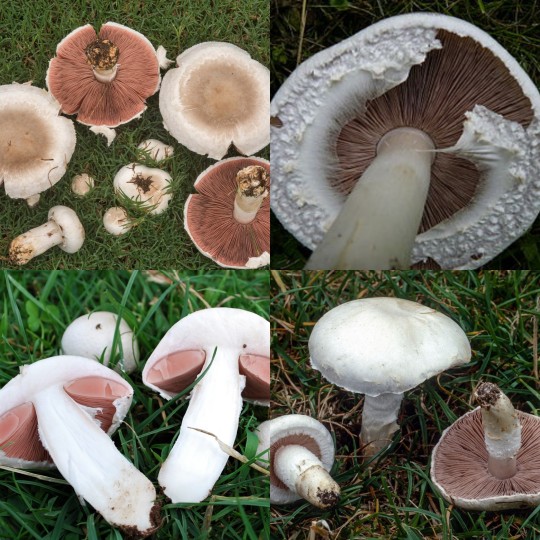
Find:grows in grassy areas, meadows and fields, often in a ring.
Time:spring, summer, or fall.
Description:cap is up to 10 cm broad, convex, white to creamy, dry, smooth.older specimens have a nearly flat cap.flesh is white, firm.gills are crowded, free from the stem, progressing from bubble-gum pink to chocolate brown with age.stem is smooth, white.partial veil is smooth, white, and leaves a single, thin ring on the stem.stem does not have a bulbous base.flesh slowly bruises off-white, to dingy brown, NOT staining yellow, orange or red.warning: discard specimens that do not have the bubblegum-pink pink gills or who's flesh stains yellow, orange, or red. these can be poisonous look-alikes.less regular shape of the cap.
Look alikes:Destroying angel there's no antidote and 60-80% of people don't survive.Caps of the Destroying Angel are 5 to 10cm in diameter, pure white, and without any marginal striations. The cap is initially egg-shaped and then campanulate (bell shaped) or occasionally almost flat but with a broad umbo, and is often tilted on the stipe.Although some young caps carry white remains of the universal veil, they soon wash off in wet weather and are rarely seen on mature caps.Amanita virosa gills are white, free and crowded.Stems of Destroying Angels are 9 to 15cm tall, 0.6 to 2cm in diameter, and often slightly curved; pure white and fibrous with an ungrooved, fragile ring high up on the stipe. The large, sack-like volva is usually buried deep in the soil.Mature specimens have a faint sickly and unpleasant odour.Often found at the edge of deciduous or mixed woodland.
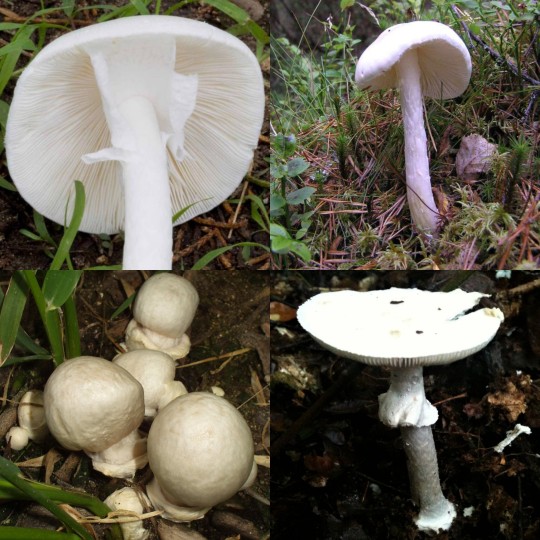
Mica Cap
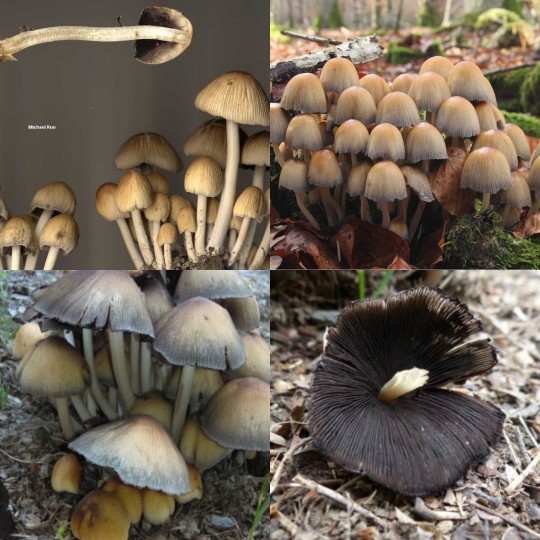
Find:They tend to favour stumps, logs, and buried wood. Most of the time, the mushrooms grow on wood or right next to wood. Sometimes they are at the bases of trees, even when the trees seem healthy.
Time:spring, summer, and fall.
Description:The Mica Cap is not very picky about the type of wood it decomposes.feature brown caps coated with a distinctive dusting of salt-like or mica-like granules. The unique combination of size, habitat, and salt-like granules makes mica caps instantly recognizable. Caps are reddish-brown to tawny to ochre-brown, becoming grayish particularly near the margin. The surface is covered by listening granules that are soon lost. The cap is radially lined almost to the centre. The mushrooms grow larger than many inky caps, cap size reaches sizes of 2 to 6cm wide.Attached to the stem or free from it; when young, gills are pale, becoming brown, then black; deliquescing (turning to black "ink") but usually not completely. Gills grow close together or crowded.You should collect only specimens that have not yet begun to liquefy. Mica caps must be cooked and eaten almost immediately after collecting as they will begin to deliquesce or dissolve into an inky black spore filled liquid within 1 to 3 hours.
Look alikes:edible Inky cap is up to 8 cm broad, light gray or gray-brown with furrow-lines radiating to the edges.gills are nearly free from the stem and white/grey when young.the flesh and gills of older specimens liquefies into a black inky mass when old.partial veil leaves an inferior, fibrous ring on the white stem.tip: collect younger specimens and/or remove blackening areas which have a more bitter taste.tip: cooking with water shortly after collecting helps to prevent the dish from turning into a black inky mess.warning: causes a reaction of hot flushing and nausea if consumed with or followed by alcohol.Do not consume this mushroom unless abstaining from alcohol.
Shaggy Mane

Find:grow in disturbed grounds, grass, wood chips, or hard-packed soil. They often appear shortly after a good rainfall.
Time:summer and autumn.
Description:they're only edible in their early stages.The shaggy mane has very distinguishing features. Its cap typically measures 5 to 14 cm tall, and is 2.5 to 4.5 cm across. It is columnar, becoming bell-shaped. The surface is dry, white with a brown central disc, breaking into coarse, white and brown recurved scales.Height: The stalks generally reach 15cm tall and are 1 to 2 cm thick. Stems are hollow, with a string-like strand of fibers hanging inside.Gills are white, adnexed to free (close together), free gills that eventually become black and inky.
Look alikes:edible Inky cap is up to 8 cm broad, light gray or gray-brown with furrow-lines radiating to the edges.gills are nearly free from the stem and white/grey when young.the flesh and gills of older specimens liquefies into a black inky mass when old.partial veil leaves an inferior, fibrous ring on the white stem.tip: collect younger specimens and/or remove blackening areas which have a more bitter taste.tip: cooking with water shortly after collecting helps to prevent the dish from turning into a black inky mess.warning: causes a reaction of hot flushing and nausea if consumed with or followed by alcohol. Do not consume this mushroom unless abstaining from alcohol.
#inky caps#jelly ears#king Bolete cep#lobster mushroom#meadow mushroom#mica cap#shaggy Mane#foraging#mushrooms#fungus#fungi#edible#dehydration
6 notes
·
View notes
Note
how do u know which ones to eat and which to not eat??
usually the ones you can eat are all kinds of boletes - which are very easy to recognise because despite coming in all kinds of shapes and sizes, the top of their caps are brown and the underside is porous and sponge-like, as opposed to exposed lamella/gills in most other mushrooms
really checking the underside of the cap is the easiest method, since all boletaceae have a spongy porous underside, but keep in mind that there are some species of boletes that aren’t edible - although you can usually recognise them very easily by them being slightly more reddish and having an unpleasant smell. most of them are very bitter if you lick them, too.
but generally, if you find a mushroom that has a cap thats brown on the top, porous on the underside, whose flesh is white or very bright beige and has a pleasant mushroomy smell, you can be sure that’s an edible bolete.
things get a bit more complicated with other mushrooms. especially if you wanna look for some saffron milk caps, which are delicious but very easy to mistake for other types of milk caps which can range from kinda gross to mildly poisonous.
there are also parasol mushrooms which i like very much but those are quite easy to mistake for certain very poisonous species of amanita. so i’d recommend looking up pictures of them to make sure you have the right mushroom
5 notes
·
View notes
Photo
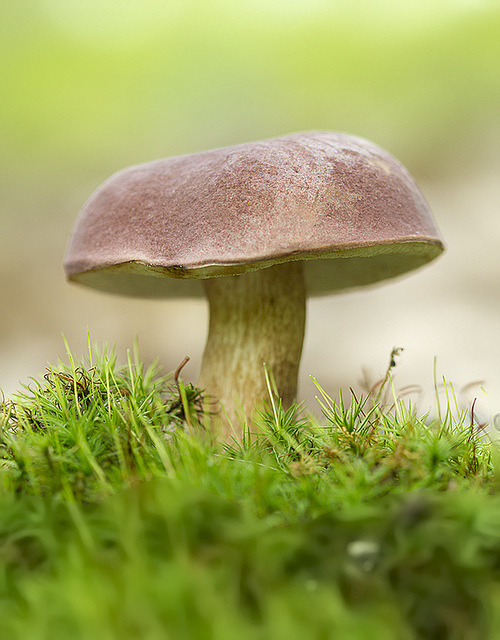
Reddish Brown Bitter Bolete - Tylopilus rubrobrunneus
This is a beautiful but very bitter tasting bolete, scientifically named Tylopilus rubrobrunneus (Boletaceae). It is found in North America, and is very common in some years, and seemingly absent in others.
Tylopilus rubrobrunneus is one of the largest boletes in the genus, at times having a cap as wide as a dinner plate.
References: [1] - [2] - [3]
Photo credit: ©Nathan Crawford | Locality: not indicated (2010)
#nature#mushrooms#reddish brown bitter bolete#tylopilus rubrobrunneus#tylopilus#north america#fungus#fungi#basidiomycota#agaricomycetes#boletales#boletaceae#mycology#original
244 notes
·
View notes
Photo

Reddish brown bitter bolete
Tylopilus rubrobrunneus (Boletaceae) is a species of North American bolete, very common in some years, and seemingly absent in others.
When young, the color of this bolete is dark-violaceus brown to chocolate, slowing changing to deep vivacious-brown, and finally a dingy cinnamon in age.
As its common name suggests, this beautiful mushroom is very bitter tasting.
References: [1] - [2]
Photo credit: ©Nathan Crawford
Locality: unknown
#nature#reddish brown bitter bolete#tylopilus rubrobrunneus#tylopilus#north america#basidiomycota#agaricomycetes#boletales#boletaceae#fungus#fungi#mycology#original
92 notes
·
View notes